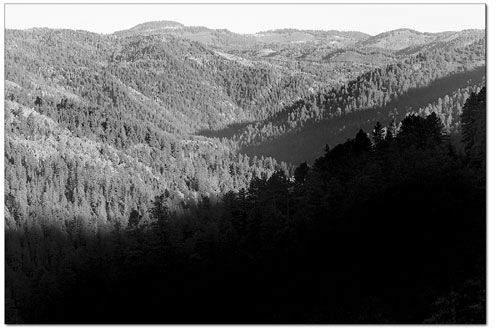| ||
| A reprieve for roadless areas Roadless areas regain protection SideStory: A shift in the HD Mountains Roadless Area
by Will Sands Roadless area advocates are breathing a sigh of relief after a Sept. 20 court order reinstated protection for the pristine public lands throughout the country. However, the relief may be short lived. Two lawsuits seeking to strip the protection have already been filed and a challenge from the Bush Administration is also expected. The Roadless Area Conservation Rule was originally adopted in 2001 and provided protection for 60 million acres of designated roadless areas from new roads and natural resource extraction. In La Plata County, it created safe havens on more than 600,000 acres in the HD Mountains, along Missionary Ridge and in the Hermosa Creek drainage. In the lead-up to the decision, the Forest Service also received unprecedented levels of feedback. More than 1.7 million official comments were lodged by members of the public, five times more than with any other federal proposal, and more than 95 percent of them were in favor of protecting roadless areas. The tides shifted in the summer of 2004, however, when the Bush Administration announced that it would be “modifying” the Roadless Area Conservation Rule. Disregarding the public comment, the modification shifted responsibility for roadless area protection to state’s governors. Conservationists fired back, charging that the decision favored special interests. At the time, Phil Clapp, president of the National Environmental Trust, commented, “This is the biggest single giveaway to the timber industry in the history of the national forests. The day the administration’s proposal takes effect, every acre of the remaining untouched 30 percent of the national forests will lose protection from logging, mining and oil drilling.” Last week, U.S. District Judge Elizabeth Laporte ruled that the federal government did not review the environmental impacts of the modification. As a result, she reinstated the 2001 rule, a decision applauded by conservationists locally and nationally. “We’re thrilled with the court ruling,” said Mark Pearson, executive director of the San Juan Citizens Alliance. “I think it confirms what the public felt all along. More than a million people came out in favor of protecting roadless areas for the 2001 rule. The Bush Administration simply threw those comments out the door when it instated its new rule.” William Meadows, president of the Wilderness Society, concurred, saying that last week’s decision is victory for the American public. “This decision is a stark repudiation of the Administration’s push to ignore the public’s wishes and turn over our public lands to special interests,” he said. Curiously, the decision arrived just one week after Colorado completed its work to abide by the new Bush modification. A task force conducted more than a year of forums, discussions and attempts to gauge the will of the Colorado public before calling for protection for most of Colorado’s 4.4 million designated roadless acres. After hearing the court ruling, Governor Bill Owens affirmed the work of the task force. “The bipartisan, collaborative process we have undertaken in Colorado is the appropriate way to determine our state’s position concerning roadless areas,” Owens wrote in a statement. On the flip side, Laporte’s ruling faced immediate legal challenges. A timber company in Oregon filed the first appeal just days later; the State of Wyoming asked a federal court to reinstate a 2003 ruling overturning the roadless rule; and the Bush Administration was also carefully considering whether to file its own appeal. With these things in mind, many conservation groups are not holding their breath. “We are cautiously optimistic, but obviously LaPorte’s ruling is probably not the last word on this,” commented Brian O’Donnell, of Trout Unlimited’s Durango-based public lands initiative. “Right now, this is good news for roadless areas, but we’ll stand by and see how it plays out.” O’Donnell said the prime responsibility for roadless area protection still lies with members of the public. With the appeals and the uncertainty of future protection, he encouraged citizens to keep a watchful eye on some of their most pristine acreage. “People need to remain vigilant,” he concluded. “The management of roadless areas and all of the backcountry has been a source of debate for decades. People need to stay active to ensure that these places will continue to be protected.” •
|


